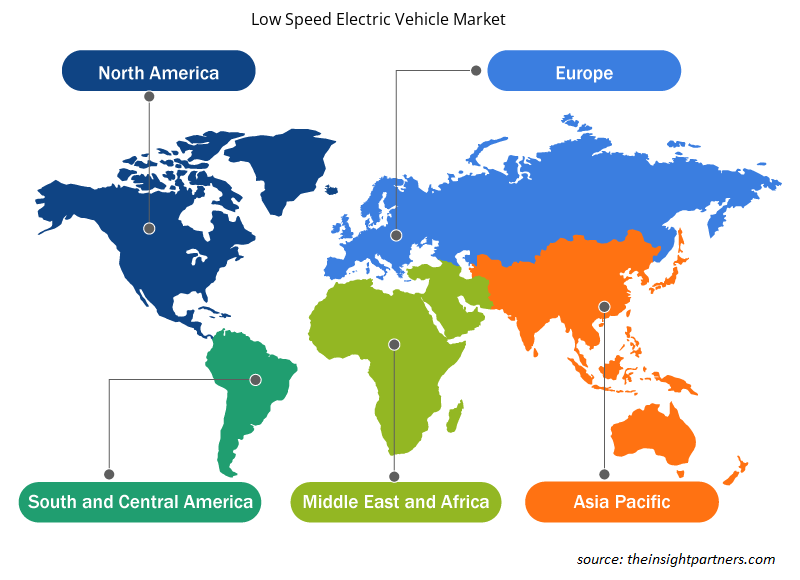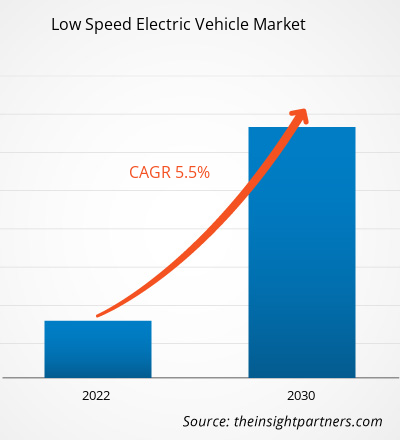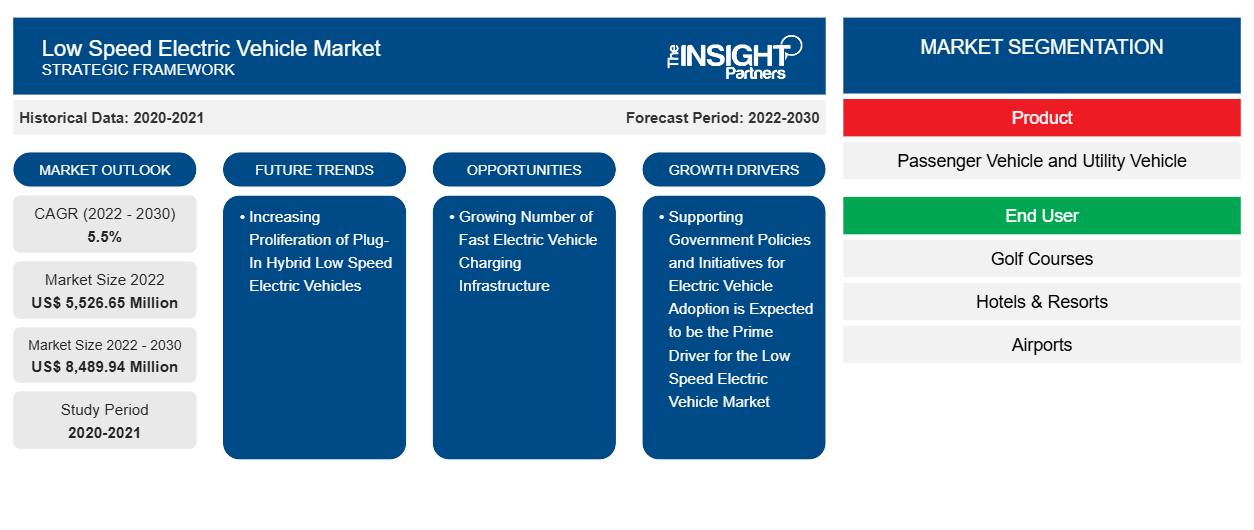Der Markt für langsame Elektrofahrzeuge belief sich im Jahr 2022 auf 5.526,65 Millionen US-Dollar und dürfte von 2022 bis 2030 eine durchschnittliche jährliche Wachstumsrate von 5,5 % verzeichnen, sodass er bis 2030 8.489,94 Millionen US-Dollar ausmachen wird. Die zunehmende Betonung der Verbesserung der Kraftstoffeffizienz dürfte ein wichtiger Trend auf dem Markt bleiben.
Marktanalyse für langsame Elektrofahrzeuge
Der globale Markt für langsame Elektrofahrzeuge hat in den letzten Jahren einen bemerkenswerten Wandel erlebt, der einen erheblichen Anstieg des Handels und der Verbreitung umweltfreundlicher Fahrzeuge markiert. Im Jahr 2022 erlebte die Importdynamik von Elektro- und Hybridautos eine bemerkenswerte Entwicklung, die eine wachsende Präferenz für nachhaltige Mobilitätslösungen widerspiegelt. Insbesondere die erhebliche Verschiebung bei den importierten Arten von Elektro- und Hybridautos treibt die Entwicklung des Marktes für langsame Elektrofahrzeuge weltweit voran.
Marktübersicht für langsame Elektrofahrzeuge
Der Markt für langsame Elektrofahrzeuge hat einen bemerkenswerten Wandel durchgemacht, da die Verkäufe von vollelektrischen Fahrzeugen einen Aufwärtstrend verzeichneten. Da die Verbraucher umweltfreundliche Alternativen bevorzugen und sich von Dieselfahrzeugen abwenden, wird die Entwicklung des Marktes für langsame Elektrofahrzeuge im Prognosezeitraum voraussichtlich vorangetrieben. Die Automobilindustrie implementiert alternative Lösungen, um die sich entwickelnden Emissionsvorschriften verschiedener Gesetzgeber einzuhalten.
Passen Sie diesen Bericht Ihren Anforderungen an
Sie erhalten kostenlos individuelle Anpassungen an jedem Bericht, einschließlich Teilen dieses Berichts oder einer Analyse auf Länderebene, eines Excel-Datenpakets sowie tolle Angebote und Rabatte für Start-ups und Universitäten.
-
Holen Sie sich die wichtigsten Markttrends aus diesem Bericht.Dieses KOSTENLOSE Beispiel umfasst eine Datenanalyse von Markttrends bis hin zu Schätzungen und Prognosen.
Treiber und Chancen auf dem Markt für langsame Elektrofahrzeuge
Unterstützung staatlicher Maßnahmen und Initiativen zur Einführung von Elektrofahrzeugen zur Förderung des Marktes
Die zunehmende Umweltverschmutzung durch fossile Brennstoffe ist eines der größten Anliegen der Regierung. Um das Ausmaß der Umweltverschmutzung zu reduzieren, legen verschiedene Regierungen Wert darauf, dass die Verbraucher sauberere, nachhaltigere und umweltfreundlichere Alternativen wählen, indem sie spezielle Rabatte auf Verkäufe, Anreize, lukrative Angebote und Steuervorteile gewähren. China, Japan, die Europäische Union, Indien, Kanada und Südkorea sind einige der wichtigsten Regionen, in denen die Regierungen aktiv daran arbeiten, die Einführung von langsamen Elektrofahrzeugen zu fördern, was voraussichtlich die Entwicklung des Marktes für langsame Elektrofahrzeuge im Prognosezeitraum vorantreiben wird.
Steigende Erschwinglichkeit von Elektrofahrzeugen mit niedriger Geschwindigkeit
Batterien sind ein wichtiger Bestandteil von Elektrofahrzeugen . Dank des technologischen Fortschritts und der sinkenden Batteriepreise werden Elektrofahrzeuge immer erschwinglicher. Die zunehmende Erschwinglichkeit und die zunehmenden staatlichen Initiativen zur Gewährung von Steuererleichterungen für die Entscheidung für Elektrofahrzeuge dürften das Wachstum des Marktes für langsame Elektrofahrzeuge in den kommenden Jahren vorantreiben.
Segmentierungsanalyse des Marktberichts für langsame Elektrofahrzeuge
Wichtige Segmente, die zur Ableitung der Marktanalyse für langsame Elektrofahrzeuge beigetragen haben, sind Produkt und Endbenutzer.
- Basierend auf dem Produkt ist der Markt für langsame Elektrofahrzeuge in Personenkraftwagen und Nutzfahrzeuge unterteilt . Das Personenkraftwagensegment hatte im Jahr 2022 einen größeren Marktanteil.
- Basierend auf den Endverbrauchern ist der Markt für langsame Elektrofahrzeuge in Golfplätze, Hotels und Resorts, Flughäfen, Wohn- und Geschäftsräume und andere unterteilt. Das Segment Golfplätze hatte im Jahr 2022 einen größeren Marktanteil.
Marktanteilsanalyse für langsame Elektrofahrzeuge nach geografischer Lage
Der geografische Umfang des Marktberichts für langsame Elektrofahrzeuge ist hauptsächlich in fünf Regionen unterteilt: Nordamerika, Asien-Pazifik, Europa, Naher Osten und Afrika sowie Süd- und Mittelamerika.
Der Umfang des Marktberichts für langsame Elektrofahrzeuge umfasst Nordamerika (USA, Kanada und Mexiko), Europa (Russland, Großbritannien, Frankreich, Deutschland, Italien und den Rest Europas), den asiatisch-pazifischen Raum (Südkorea, Indien, Australien, Japan, China und den Rest des asiatisch-pazifischen Raums), den Nahen Osten und Afrika (Saudi-Arabien, Südafrika, die Vereinigten Arabischen Emirate und den Rest des Nahen Ostens und Afrikas) sowie Süd- und Mittelamerika (Argentinien, Brasilien und den Rest Süd- und Mittelamerikas). In Bezug auf den Umsatz dominierte Nordamerika im Jahr 2022 den Marktanteil für langsame Elektrofahrzeuge. Der asiatisch-pazifische Raum ist der zweitgrößte Beitragszahler zum globalen Markt für langsame Elektrofahrzeuge, gefolgt von Europa.
Regionale Einblicke in den Markt für langsame Elektrofahrzeuge
Die regionalen Trends und Faktoren, die den Markt für langsame Elektrofahrzeuge im gesamten Prognosezeitraum beeinflussen, wurden von den Analysten von Insight Partners ausführlich erläutert. In diesem Abschnitt werden auch Marktsegmente und Geografien für langsame Elektrofahrzeuge in Nordamerika, Europa, im asiatisch-pazifischen Raum, im Nahen Osten und Afrika sowie in Süd- und Mittelamerika erörtert.

- Erhalten Sie regionale Daten zum Markt für langsame Elektrofahrzeuge
Umfang des Marktberichts für langsame Elektrofahrzeuge
| Berichtsattribut | Details |
|---|---|
| Marktgröße im Jahr 2022 | 5.526,65 Millionen US-Dollar |
| Marktgröße bis 2030 | 8.489,94 Millionen US-Dollar |
| Globale CAGR (2022 - 2030) | 5,5 % |
| Historische Daten | 2020-2021 |
| Prognosezeitraum | 2022–2030 |
| Abgedeckte Segmente |
Nach Produkt
|
| Abgedeckte Regionen und Länder |
Nordamerika
|
| Marktführer und wichtige Unternehmensprofile |
|
Marktteilnehmerdichte für langsame Elektrofahrzeuge: Auswirkungen auf die Geschäftsdynamik verstehen
Der Markt für langsame Elektrofahrzeuge wächst rasant, angetrieben durch die steigende Nachfrage der Endnutzer aufgrund von Faktoren wie sich entwickelnden Verbraucherpräferenzen, technologischen Fortschritten und einem größeren Bewusstsein für die Vorteile des Produkts. Mit der steigenden Nachfrage erweitern Unternehmen ihr Angebot, entwickeln Innovationen, um die Bedürfnisse der Verbraucher zu erfüllen, und nutzen neue Trends, was das Marktwachstum weiter ankurbelt.
Die Marktteilnehmerdichte bezieht sich auf die Verteilung der Firmen oder Unternehmen, die in einem bestimmten Markt oder einer bestimmten Branche tätig sind. Sie gibt an, wie viele Wettbewerber (Marktteilnehmer) in einem bestimmten Marktraum im Verhältnis zu seiner Größe oder seinem gesamten Marktwert präsent sind.
Die wichtigsten Unternehmen auf dem Markt für langsame Elektrofahrzeuge sind:
- Textron Inc
- Yamaha Motor Co Ltd
- Club Auto
- Die Toro Co
- Renault SA
- Star EV
Haftungsausschluss : Die oben aufgeführten Unternehmen sind nicht in einer bestimmten Reihenfolge aufgeführt.

- Überblick über die wichtigsten Akteure auf dem Markt für langsame Elektrofahrzeuge
Nachrichten und aktuelle Entwicklungen zum Markt für langsame Elektrofahrzeuge
Der Markt für langsame Elektrofahrzeuge wird durch die Erhebung qualitativer und quantitativer Daten nach Primär- und Sekundärforschung bewertet, die wichtige Unternehmensveröffentlichungen, Verbandsdaten und Datenbanken umfasst. Nachfolgend sind einige der Entwicklungen auf dem Markt für langsame Elektrofahrzeuge aufgeführt:
- Waev Inc. kündigte an, dass es für seine GEM-Elektrofahrzeuge optional Solarmodule auf dem Dach einbauen werde. GEM-Mikroautos, auch Langsamfahrfahrzeuge oder Nachbarschafts-Elektroautos genannt, sind leichte, effiziente Fahrzeuge, die für den Einsatz über kurze Distanzen konzipiert sind und eine Höchstgeschwindigkeit von 25 Meilen pro Stunde erreichen. (Quelle: Waev Inc, Pressemitteilung, August 2023)
- Arcimoto expandierte in weitere wichtige Märkte an der West- und Ostküste und nahm Kundenbestellungen in Connecticut, North Carolina, South Carolina und New Mexico entgegen. Die Auslieferungen beginnen in diesem Frühjahr. Arcimoto-Fahrzeuge sind jetzt in Kalifornien, Oregon, Washington, Hawaii, Nevada, Arizona, New Mexico, Florida, New York, New Jersey, Connecticut, Pennsylvania, Maryland, Virginia, Washington DC, North Carolina, South Carolina und Georgia erhältlich. (Quelle: Arcimoto, Pressemitteilung, Mai 2023)
Marktbericht zu langsamen Elektrofahrzeugen – Abdeckung und Ergebnisse
Der Bericht „Marktgröße und Prognose für langsame Elektrofahrzeuge (2020–2030)“ bietet eine detaillierte Analyse des Marktes, die die folgenden Bereiche abdeckt:
- Marktgröße und Prognose für langsame Elektrofahrzeuge auf globaler, regionaler und Länderebene für alle wichtigen Marktsegmente, die im Rahmen des Berichts abgedeckt sind
- Markttrends für langsame Elektrofahrzeuge sowie Marktdynamik wie Treiber, Einschränkungen und wichtige Chancen
- Detaillierte PEST- und SWOT-Analyse
- Marktanalyse für langsame Elektrofahrzeuge mit Blick auf wichtige Markttrends, globale und regionale Rahmenbedingungen, wichtige Akteure, Vorschriften und aktuelle Marktentwicklungen
- Branchenlandschaft und Wettbewerbsanalyse, die die Marktkonzentration, Heatmap-Analyse, prominente Akteure und aktuelle Entwicklungen für den Markt für langsame Elektrofahrzeuge umfasst
- Detaillierte Firmenprofile
- Historische Analyse (2 Jahre), Basisjahr, Prognose (7 Jahre) mit CAGR
- PEST- und SWOT-Analyse
- Marktgröße Wert/Volumen – Global, Regional, Land
- Branchen- und Wettbewerbslandschaft
- Excel-Datensatz
Aktuelle Berichte
Verwandte Berichte
Erfahrungsberichte
Grund zum Kauf
- Fundierte Entscheidungsfindung
- Marktdynamik verstehen
- Wettbewerbsanalyse
- Kundeneinblicke
- Marktprognosen
- Risikominimierung
- Strategische Planung
- Investitionsbegründung
- Identifizierung neuer Märkte
- Verbesserung von Marketingstrategien
- Steigerung der Betriebseffizienz
- Anpassung an regulatorische Trends























 Kostenlose Probe anfordern für - Markt für langsame Elektrofahrzeuge
Kostenlose Probe anfordern für - Markt für langsame Elektrofahrzeuge